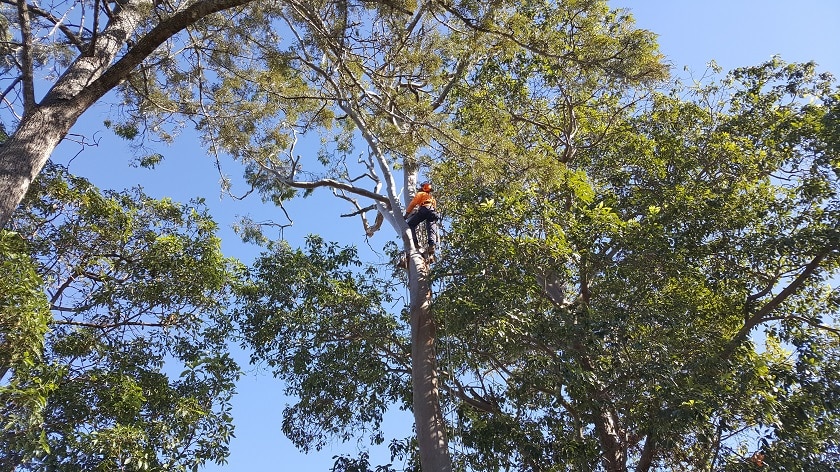As arborists our motto is, “helping people and trees live together”. Nevertheless, people come first to us, so if you can’t live with your trees it’s our job to remove them. In fact, often when our customers have their trees removed it’s because we’ve had to recommend it.
Do you need trees removed because:
- You have dangerous trees?
- Your trees are too close to your house?
- They are environmental weed trees?
Try our tree removal cost estimator.
Dangerous trees.
As qualified arborists we are trained and qualified to assess trees for hazards. Trees can become dangerous due to
- Regrowth after storm damage or pruning by unqualified arborists and tree loppers.
Regrowth is usually weakly held at the branch union, especially if there are several shoots coming from the one branch. Australian Standard AS4373-1999 Pruning of Amenity Trees states these epicormic branches should all be removed. Brisbane Trees and Gardens would like the Australian Standard to be improved to take into account research by leading arborists that suggests these branches can be remediated by removing some of the shoots and permitting one or two to take over. Firstly though, we will protect your people, your home, and your property. - Hazardous growth forms – trees with codominant leaders growing at acute angles tend to get included bark caught in the branch union. Studies have shown codominant branches with inclusions are over 30% weaker than other branches.
- Mechanical damage – Trees damaged by abrasion with structures, vehicles or other trees should be assessed for adequate recovery. Trees recover through compartmentalisation of wounds and their progress in forming wound wood can be judged from the ground in most cases.
- Climatic conditions – lack of rain or nutrients are the most common climatic conditions to weaken trees’ ability to maintain their integrity. It’s when trees are stressed that they then become prone to infection by:
- Insects, especially borers and termites, can effectively hollow out so much of the sound wood of a tree that it is no longer sound. After insects have damaged the wood it can go into decline leading to:
- Fungal and bacterial pathogens. Usually occurring after decline due to injury, stress, insect attack, or wounding, infection by fungus and bacteria is often fatal for trees. We can attempt to identify the species of pathogen and, if a non-fatal species, recommend treatment and management of your tree to aid its recovery.
Often we can suggest remediation of tree faults to mitigate the risk, but if your tree needs to be removed we won’t hesitate to advise you of it.
Trees near houses or driveways.
The Australian Standard AS2870 – 2011 states trees should not be closer than the height of the of the mature tree to a house on class H and M sites, and not closer than 1.5 times the height of the mature tree to a house on type E sites. Rows or groups of trees should be at least twice the height of the trees from a house.
Environmental Weeds
Some exotic trees displace our native trees which then deprives our native fauna of the food and shelter they need. Others directly damage our fauna, for example, African tulip trees poison our native bees and oleander is toxic to herbivores.
Common environmental weed trees in Brisbane include:
Celtis sinensis, Chinese elm. Syagrus romanzoffiana, cocos palm.
Spathodea campanulata, African tulip. Koelreutaria elegans, golden rain tree.
Cassia fisula, golden shower tree. Corymbia torelliana, cadaghi.
Archontophoenix alexandrae, alex palm. Cinamomum camphora, camphor laurel.
We will always recommend the removal of environmental weeds and their replacement with desirable species, usually Australian natives.
How we remove trees.
Tree removal is a dangerous job that we do safely. We suggest you only employ an arborist to advise your on your trees as per the Australian Standard AS4373-2007 Pruning of Amenity Trees. We further follow the ‘Guide to Managing Risks of Tree Trimming and Removal Work’ by the federal government’s Safe Work Australia. Additionally we prepare a safety evaluation for every tree we remove. We don’t take chances.
We remove trees using state-of-the-art equipment and following carefully-documented safety procedures. Our training and qualifications guide us on know how to use and follow them properly.
Our Safe Work Method Statements are available for viewing on our downloads page, as is our Insurance Certificate.
References
https://www.safeworkaustralia.gov.au/system/files/documents/1702/guide-to-managing-risks-tree-trimming-removal-01082016.pdf
Qbcc.qld.gov.au. (2018), Standards and Tolerances Guide, QBCC, Brisbane.
Standards Australia 2007, AS4373-2007 Pruning of Amenity Trees, Standards Australia, NSW.

